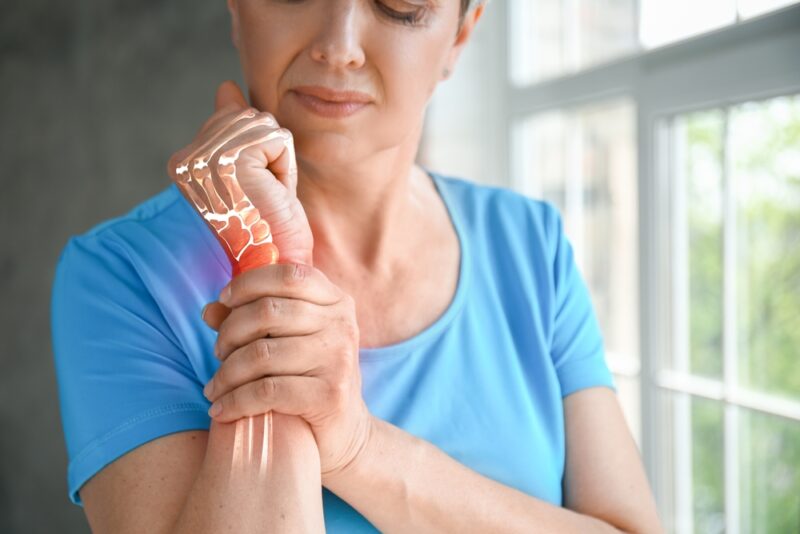Understanding Osteoporosis in Women
As women enter menopause, they become more vulnerable to osteoporosis, a debilitating condition that causes weakened bones and increases the risk of fractures. At Walnut Lake OBGYN & Wellness in West Bloomfield, MI, we believe it is vital to understand the impact of osteoporosis on overall health and well-being. Osteoporosis in women is a serious concern, as it can cause chronic pain, mobility limitations, and even disability.
By gaining a deeper understanding of this condition, we can take preventative measures and receive early treatment to reduce their risk of developing osteoporosis. In this blog post, Walnut Lake OBGYN & Wellness will explore the causes and symptoms of osteoporosis, as well as important prevention and treatment strategies.
What is Osteoporosis?
Osteoporosis is a condition that greatly impacts bone health, causing bones to become weak and brittle. According to the CDC, 19.6% of women over 50 have osteoporosis, compared to 4.4% of men. Women are more likely than men to develop osteoporosis due to factors such as hormonal changes during menopause and a lower peak bone density. This condition increases the risk of fractures, making even simple activities like bending or coughing potentially dangerous. It is crucial to understand the prevalence and consequences of this condition to take preventive measures and seek appropriate treatment.
What Causes Osteoporosis in Women?
Hormonal changes, such as decreased estrogen levels during menopause, can contribute to bone loss and increased risk. Genetic factors can also play a role, as having a family history of osteoporosis may predispose women to the condition. Additionally, lifestyle choices like low calcium and vitamin D intake, lack of physical activity, smoking, excessive alcohol consumption, and certain medications can further increase the risk. By addressing these factors and implementing preventive measures, women can safeguard their bone health and reduce the likelihood of developing osteoporosis.
The Impact of Osteoporosis in Women’s Health
Women with osteoporosis are at a higher risk of fractures, particularly in the hip, wrist, and spine, which can cause severe pain and disability. Fractures in the vertebrae can result in a stooped posture, loss of height, and chronic back pain, impacting quality of life. It’s important to be aware of these consequences and take proactive measures to protect their bone health, such as engaging in weight-bearing physical activity, like walking, jogging, aerobics, and more, and ensuring adequate intake of calcium and vitamin D.
Signs and Symptoms
It’s important to be aware of the common signs and symptoms of osteoporosis so you can seek timely medical attention. Among the indications to watch out for is:
- Bone pain is often experienced in the back or neck.
- Fractures, especially in the spine, hip, or wrist, are a significant symptom of osteoporosis.
- Height loss can also occur due to compression fractures in the spine.
By being vigilant for these signs and symptoms, women can take proactive measures to prevent further bone loss and seek appropriate treatment from healthcare professionals like Walnut Lake OBGYN & Wellness.
How to Diagnose Osteoporosis in Women
Detecting osteoporosis involves diagnostic methods like bone density scans and imaging tests. Dual-energy X-ray absorptiometry (DXA) is one of the most common bone density scans to assess bone strength. This non-invasive scan measures the bone mineral density and compares it to the average for the patient’s age group. Other imaging tests, such as X-rays and computed tomography (CT) scans, may be used to identify existing fractures or structural abnormalities in the bones.
Treatment Options
There are various treatment options available to manage the condition effectively. Medications such as bisphosphonates, hormone replacement therapy (HRT), selective estrogen receptor modulators (SERMs), and calcitonin can help slow down bone loss and reduce the risk of fractures. These medications work by either increasing bone density or regulating hormone levels. In addition to medication, lifestyle changes can also play a significant role in managing osteoporosis.
Lifestyle Modifications
Lifestyle modifications can be crucial in managing osteoporosis, particularly in reducing the risk of fractures. Fall prevention is one of the primary focuses for those living with osteoporosis and involves measures such as removing obstacles in the home, wearing shoes with good support, and using assistive devices as necessary. Adequate calcium and vitamin D supplementation is also critical in maintaining bone health and can be achieved through supplements or a nutritious diet. Smoking cessation is also essential, given the link between tobacco use and reduced bone mass. By adopting these lifestyle modifications, women with osteoporosis can effectively manage their condition and reduce the risk of fractures.
It is important to consult your healthcare professionals to evaluate their individual condition and determine the most suitable treatment approach for managing osteoporosis.
Supporting Women With Osteoporosis
Navigating osteoporosis can be challenging, and having emotional support is crucial in coping with the physical and emotional aspects of the condition. Connecting with community resources and support groups can provide valuable information, encouragement, and a sense of camaraderie for those diagnosed with osteoporosis.
Additionally, healthcare professionals like Walnut Lake OBGYN & Wellness are vital in providing guidance, personalized treatment plans, and ongoing monitoring to ensure optimal condition management. By accessing emotional support, community resources, and healthcare professionals, individuals with osteoporosis can feel empowered and better equipped to address the challenges associated with the condition.
Promoting Bone Health at All Stages of Womanhood
Maintaining bone health is important at every stage of life, starting from adolescence. During adolescence, it is crucial to ensure optimal bone growth and development through a balanced diet rich in calcium and vitamin D, along with regular exercise.
Pregnancy places increased demands on the body, making it essential to maintain an adequate intake of nutrients, including calcium and vitamin D, to support bone health for both mother and baby.
Menopause brings hormonal changes that can accelerate bone loss, making it vital to focus on strategies like weight-bearing exercises, calcium and vitamin D supplementation, and hormone replacement therapy to preserve bone density. By prioritizing bone health throughout these stages, women can minimize the risk of developing osteoporosis later in life and maintain strong and healthy bones.
Reach Out to Walnut Lake OBGYN & Wellness Today!
Understanding osteoporosis is crucial for women to take proactive steps in managing their bone health. Individuals can empower themselves to navigate osteoporosis effectively by recognizing the importance of lifestyle modifications, including exercise and dietary changes, and seeking emotional support, community resources, and expert guidance from healthcare professionals like Walnut Lake OBGYN & Wellness. Contact us today!

